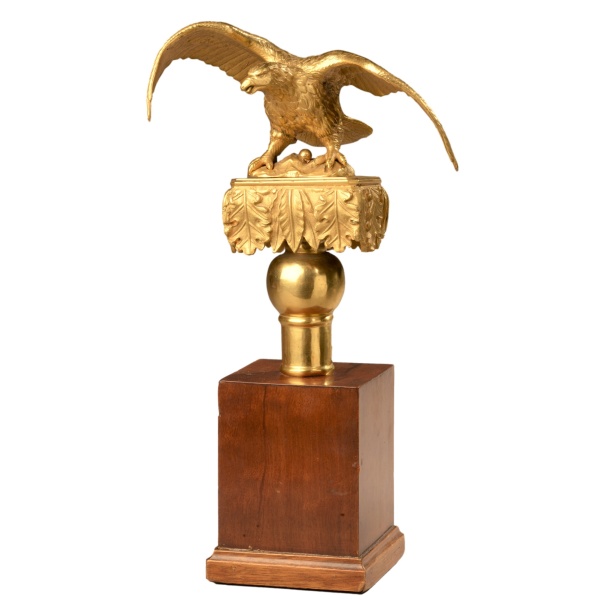Beautiful 2nd Empire Eagle Topped Gilt And Chased Bronze Flagpole

Beautiful Eagle topped flagpole in chased and gilded bronze, set on a base decorated with oak leaves and laurels, dating to the early part of the Second Empire.
The beautifully chased Eagle spreads its wing and stands on top of a base on a base decorated with oak leaves and laurels and centered with an artillery crest.
We were able to trace this precise Artillery Crest to France’s Second Empire Period and more precisely to 1857.
Napoleon the First was the one who initiated the use of Eagles on top of his flagpoles.
Proclaimed Emperor of the French on May 18, 1804, Napoleon had to define the emblems that would mark his reign and his imperial dynasty.
His advisors suggested the rooster, the eagle, the lion and the elephant (the strongest of the animals), but also the bees, or the peaceful oak.
The fleur-de-lis was automatically discarded because it was used by the monarchy overthrown by the French Revolution.
The bees were retained as a symbol of immortality and resurrection, chosen to link the new dynasty to the origins of France, and to symbolize as well the Emperor’s industriousness. They are considered to be the oldest emblem of the rulers of France.
For his armies, Napoleon chose the Eagle, the bird of Jupiter, emblem of imperial Rome, that had been associated with military victories since ancient times.
The day after the coronation on December 2, 1804, Napoleon had the symbol placed at the top of the flagpole of all the flags of the Napoleonic armies.
On December 31, 1851, Napoleon III decided to use the same symbolism as his uncle and use eagles at the top of his flagpoles. To do this, a new ceremony of distribution of eagles was organized on May 10, 1852, after the coup d’état of December 2, 1851.
The stakes were high because it gave the future Napoleon III the opportunity to gauge the loyalty of his armies. On this occasion, he brought in representatives from all the garrisons of France and Algeria.
The eagles, made from a drawing by Jean-Auguste Barre (1811-1896), then cast in gilded bronze, once again had their wings spread and their beaks more open.
This particular model belonged to the horse artillery regiment of the Imperial Guard which was formed in Versailles by decree on May 1, 1854.
Assigned to the army of the East, the regiment participated in the battle of Traktir in 1855 and in the siege of Sebastopol.
In 1859, engaged in the Italian campaign, the regiment was involved in the battles of Magenta and Solferino.
Our beautiful eagle is dated 1857 precisely….a majestic and beautiful piece with incredible chasing and patina.
France 19th Century c.H: 13"W: 7"Reference number: R-396
Click here to print.
go back
